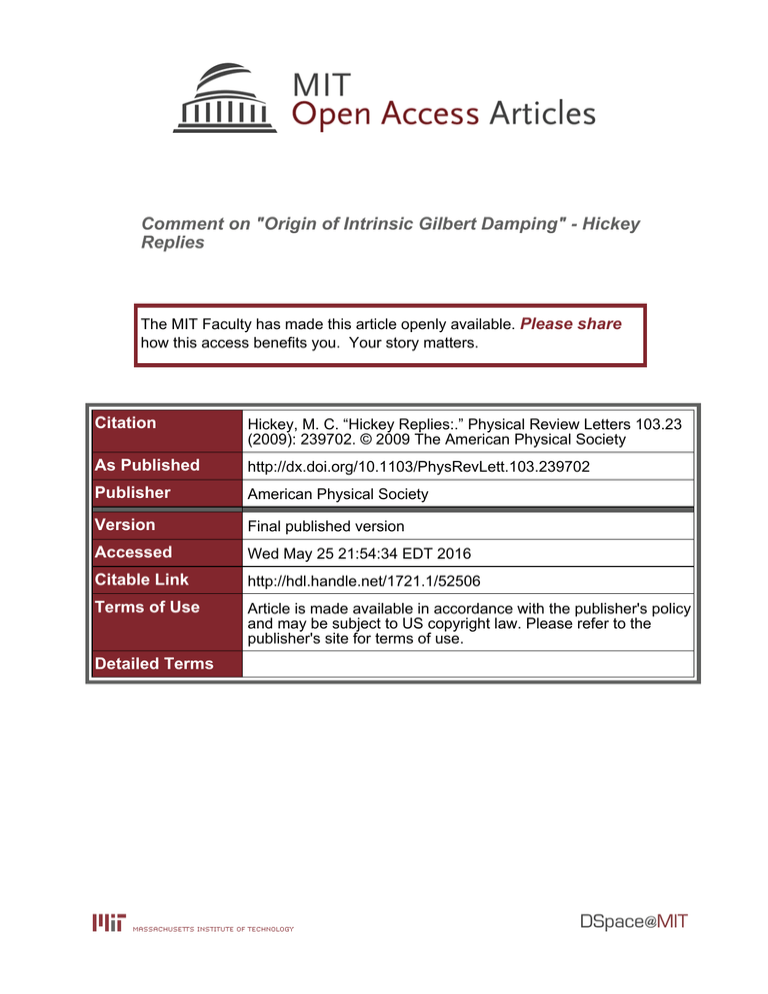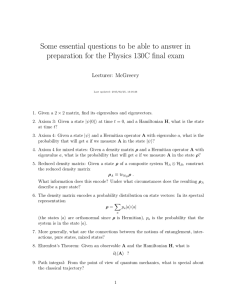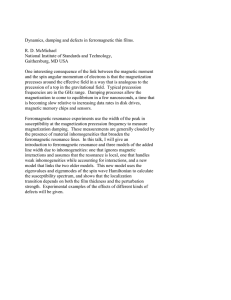Comment on "Origin of Intrinsic Gilbert Damping" - Hickey Replies Please share
advertisement

Comment on "Origin of Intrinsic Gilbert Damping" - Hickey Replies The MIT Faculty has made this article openly available. Please share how this access benefits you. Your story matters. Citation Hickey, M. C. “Hickey Replies:.” Physical Review Letters 103.23 (2009): 239702. © 2009 The American Physical Society As Published http://dx.doi.org/10.1103/PhysRevLett.103.239702 Publisher American Physical Society Version Final published version Accessed Wed May 25 21:54:34 EDT 2016 Citable Link http://hdl.handle.net/1721.1/52506 Terms of Use Article is made available in accordance with the publisher's policy and may be subject to US copyright law. Please refer to the publisher's site for terms of use. Detailed Terms PRL 103, 239702 (2009) Hickey Replies: The authors of the preceding Comment [1] correctly assert that the full spin orbital coupling Hamiltonian stated by Hickey et al. in a recent Letter [2] is Hermitian. The original article on which the Comment is based contained the same observation: ‘‘Note that, while neither spin-orbital term is Hermitian, the two terms taken together are Hermitian.’’ Let us recall the spin-orbital terms: H ¼ e@ ie@2 E p 2 2 ðr EÞ 2 2 4m0 c 8m0 c ¼ H1 þ H2 : e@ e@2 0 dM ¼ S E p þ i S ð1 þ 1 m Þ 2 2 2 2 dt 4m0 c 8m0 c (2) H S ¼ H0S þ H S ðtÞ: ^ ¼ ie@0 Ms ð1 þ ^ 1 Þ; 8m2 c2 (4) 2 1 ? ¼ !0 ! ð i ? qM!2 0 Þð1 þ i? q2 =Ms Þ 0 Ms 0 s 1 þ 2 2? q2 =Ms ; (5) where the susceptibility was written without the longitudinal response and in a basis in which the Levi-Civita tensor is diagonal and the parameters in the above equation are given by [2]. This result confirms the empirically held picture that the damping, and hence the FMR linewidth scales linearly with frequency (without an intercept) as demonstrated by Urban et al. [4]. We agree with Widom et al. that, in the limit of static electric and magnetic fields, the spin-orbital coupling is Hermitian and has a vanishing second term. However, Widom et al. did not take into account that, when the magnetization varies in time, the second term cannot be neglected, and we believe that this gives rise to dynamical Gilbert damping. (3) The Hamiltonian is now a time-dependent, anti-Hermitian interaction which is never canceled by the single particle energy of H1 and which acts as a perturbation on the system and couples to the time varying magnetization. Therefore, Gilbert damping is an emergent feature of a collective of magnetization spins. In our Letter [2], we calculate the time evolution of the magnetization in the nonequilibrium case of an open system of spins. NonHermiticity of the interaction Hamiltonian leads to irreversible, nonadiabatic and nonunitary time evolution of the density matrix [3], giving rise to dissipation, which is precisely what our theory on Gilbert damping purports to describe. In Fig. 1 of our original Letter, we have plotted the value of the Gilbert constant at ! ¼ 0 (the dc limit) using the absolute value of the transverse susceptibility tensor, and 0031-9007=09=103(23)=239702(1) not its imaginary part. However, we need to clarify that the Re½ drops to zero when ! ! 0 in the basis in which we have calculated it, as implied by the final equation of page 3 of our Letter. We conclude that a finite perturbation frequency is required—! Þ 0 (where ! corresponds to the Fourier component of the applied field perturbation) for precessional damping to take place, otherwise the system of spins (the magnetization) is in equilibrium with the field. The dimensionless Gilbert damping tensor, which determines the intrinsic linewidth of FMR resonances, reduces to [2]: (1) This Hamiltonian describes the spin-orbital coupling of single particle states in the presence of a static electric field, and it is Hermitian. In most ferromagnets, the lattice electron spins are orbitally quenched in the inversion symmetric crystal. Therefore, the first term is unimportant (spin-orbital splitting energies are negligible in most transition metal based ferromagnets). In the static case, the second term is zero (the curl of any scalar field gradient is always zero). When the magnetization evolves dynamically, however, H2 becomes nonzero due to the nonvanishing electric field curl, commensurate with the time varying magnetic induction. We import a Maxwell relation to describe this time-dependent perturbation. Let us recall the Hamiltonian in the reduced spinor basis S ¼ ð@=2Þ, as follows: HS ¼ week ending 4 DECEMBER 2009 PHYSICAL REVIEW LETTERS M. C. Hickey* Francis Bitter Magnet Laboratory Massachusetts Institute of Technology 150 Albany Street, Cambridge, Massachusetts 02139, USA Received 24 April 2009; published 3 December 2009 DOI: 10.1103/PhysRevLett.103.239702 PACS numbers: 76.20.+q, 75.30.m, 75.45.+j *mark_hickey@uml.edu [1] A. Widom, C. Vittoria, and S. D. Yoon, Phys. Rev. Lett. 103, 239701 (2009). [2] M. C. Hickey and J. S. Moodera, Phys. Rev. Lett. 102, 137601 (2009). [3] P. Kakashvili and C. J. Bolech, Phys. Rev. B 78, 033103 (2008). [4] R. Urban, G. Woltersdorf, and B. Heinrich, Phys. Rev. Lett. 87, 217204 (2001). 239702-1 Ó 2009 The American Physical Society





